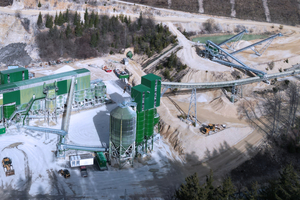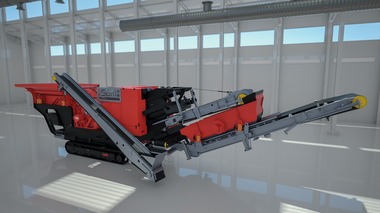SBM modernises STORZ gravel plant Neuhausen ob Eck
Founded almost 100 years ago, the family-run STORZ Group, headed by Managing Directors Susanne Gräfin Kesselstatt and Georg Graf Kesselstatt, is one of Southern Germany’s leading companies in the fields of infrastructure construction, renovation and maintenance, building materials production and environmental technology. Today, around 800 people work in the seven regional branches of J. Friedrich Storz Verkehrswegebau GmbH and other specialised subsidiaries. STORZ has been supplying its own construction sites and customers in the region with high-quality stone building materials for decades. Today, J. Friedrich Storz Baustoffe GmbH has two quarries and three asphalt mixing plants with a total of 30 employees under the leadership of Managing Director Christian Rebmann.
The gravel plant in Neuhausen ob Eck, near the STORZ headquarters in Tuttlingen, is the main operation of the building materials division. Jura limestone is quarried directly by excavator on a single level on an area of around 19 ha and transported over a distance of around 400 m to the primary crusher. The average annual production is around 250 000 to 300 000 t of aggregates and recycled aggregates.
Sustainable modernisation
Extraction has been going on since 1979 – the gravel plant was built in 1984 and a sand production line was added in the mid-1990s. The first ideas for modernising the site were already maturing in 2017, and in 2021 – still in the midst of the covid crisis – action was taken: The Swiss engineering and planning office Bilger+Partner drew up the overall concept, which aimed not only to achieve significant energy savings through more efficient production steps, but also to obtain a fundamentally higher-quality rock yield from the Neuhausen limestone, which is interspersed with fine marl layers, and to expand the range of qualified end products to include concrete aggregates. All this within the framework of the existing permits and with sustainable use of the existing plant substance.
In July 2022, the Austrian processing specialist and plant manufacturer SBM Mineral Processing was awarded the extensive contract for process modernisation. In addition to replacing the entire crushing technology with SBM crushers, the project included a new pre-screening stage to separate the marl fractions, new feed silo capacities, the expansion of existing classifiers and the connection of the new sand production line, which was converted from wet to dry processing. Supported by STORZ personnel, the SBM installation teams also dismantled plant components that were no longer required, overhauled the remaining structures and installed the plant components prepared by SBM or third party suppliers.
SBM processing technology was also used to bridge the “hot construction phase” after the old plant was shut down in November 2022 until the plant was re-opened in July 2023: On an area of approximately 3 ha, a three-stage mobile processing plant with a daily capacity of up to 2000 t (approximately 250 t/h) ensured the site’s supply capability, together with pre-produced sand batches. A REMAX 500 large impact crusher was used as primary crusher, STORZ’s own REMAX 400 alternated with a REMAX 450 in the secondary stage, and an SMR 10/5/4 semi-mobile impact crusher served as tertiary crusher for qualified fines 0/5 mm.
Reconditioning in the existing structures
The primary crusher is still located some 150 m above the main plant and has been completely overhauled in the existing housing with a newly installed dedusting system: to optimise processing, the previous combination of grid and jaw crusher has been replaced by an SBM RHS 13/16/4 horizontal impact crusher with an upstream two-stage roller screen. The latter separates grain sizes < 80/60 mm, effectively separating the marl content from the rock. The remaining raw material up to a feed size of 1200 mm is crushed to < 200 mm in the RHS 13/16/4. Designed for soft to medium-hard natural stone, the heavy and robust horizontal impact crusher offers a high degree of reduction, easy access for maintenance and low wear and energy costs at a feed rate of 350 – 450 t/h.
The marl-containing rock from the pre-screening stage is transported parallel to the pre-crushed material to the new screening station: a double-deck flip flow screen efficiently separates the marl fractions, which are stockpiled as screenings (0/5 mm, 5(10)/45 mm). The cleaned limestone is then fed back onto the conveyor to the new secondary stage of the plant. A double-deck screen above two new 225 m³ buffer silos and the existing 500 m³ main silo separates the primary crushed material into the 0 – 22 mm, 22 – 45 mm and 45 – 200 mm fractions. These can now be loaded directly via a new truck loading system without the previous diversion via external stockpiles.
The two new secondary crushers from SBM are also fed from the buffer silos: an RHSMK-5 13/13/4 horizontal impact crusher with a three- or five-row grinding track handles the coarse ballast fractions (45 – 200 mm; 200 – 300 t/h), while an SMR 10/10/4 impact crusher handles the fine fractions 0 – 45 mm (150 – 250 t/h). Both crushers are characterised by large defined valuable aggegrates fractions, good cubicity of the end products and low operating and wear costs. This applies in particular to the reversible SMR 10/10/4, which offers an economical, single-stage alternative to far more complex cone or gyratory crushers, often with downstream vertical impact crushers, particularly in the production of crushed sand and high-quality gravel.
The material is fed into the silo building via a central conveyor belt. Now four double-deck screens (+1) above the ten silos (totalling 2000 m³) produce the current delivery sizes of 45-56/32 – 45/22 – 32/16 – 22/11 – 16/8 – 11/5 – 8/2 – 5 mm as well as 0 – 2 mm classified/unclassified crushed sand. The new dry sand preparation plant with high performance air classifiers, cyclones and its own loading system is located directly adjacent to the silo building and contributes significantly to the positive energy balance of the STORZ modernisation compared to the previous washing process.
As a new tertiary crusher, a second reversible SMR 10/10/4 SBM impact crusher now recrushes the aggregates from silos 1 to 8 with hourly outputs of up to 250 t when required. This ensures the availability of high quality, high demand products at short notice, or the wide range of supplies even at off-peak times or when upstream process stages are down for maintenance.
Two new 20 m³ batching units for concrete and asphalt-containing recycled aggregates have been integrated into the existing in-line batching system, allowing the production and delivery of recycling/mineral mixes via the existing truck loading system. The recycled construction materials are processed using a track-mounted SBM REMAX 400 impact crusher and, as with all products, are quality tested in the company’s own laboratory.
Successful implementation
After a total construction period of just under eight months, the “rebuilt” STORZ crushed stone plant in Neuhausen resumed operations in July 2023. “It was a great achievement by everyone involved, considering the external circumstances – in particular the problems in the supply chains that were already prevalent at the start of the project and the further intensification of material shortages and prices with the outbreak of the Ukraine crisis,” says Christian Rebmann, who is responsible for the modernisation project at STORZ together with plant manager Matthias Kohli. “We were impressed by the cooperation with SBM even before construction began. The plant engineers made important suggestions for optimisation within our technical framework concept, and the final pricing, which was not easy, was also extremely fair and transparent for both sides,” says Christian Rebmann, praising the SBM project team.
Thanks to a fully digitalised control system from Wöhwa with extensive automation of all production stages, the entire plant can not only be operated “unmanned” with authorised remote access via tablet at any time, but an intelligent energy management system with partial shutdown of the highly efficient processing stages further increases the savings potential. Despite a 30 % increase in product output when required, additional processing steps and loading points, the installed electrical power in the plant has been reduced by a good 50 %. STORZ estimates the actual power savings in operation to be around 30 %, which equates to around 500 t less CO2 emissions per year.















